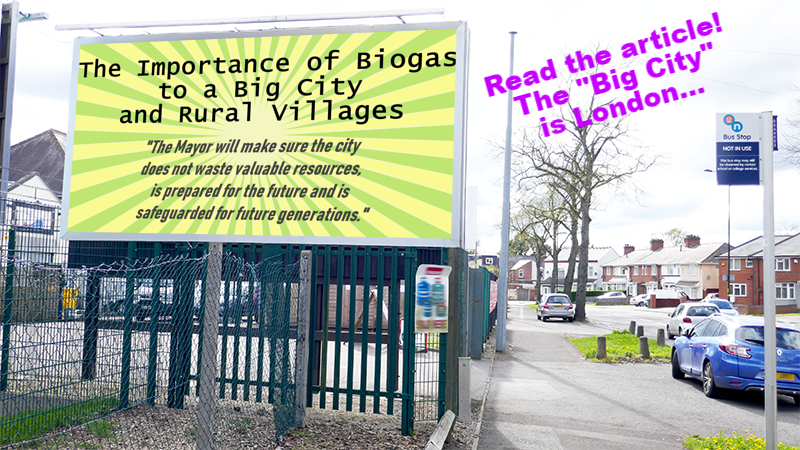Biogas is an important technology being, as it is, produced by the natural anaerobic digestion process. So, we decided to write about the importance of biogas to life in a Big City and also the importance of biogas to Rural Villages (Scroll down). But before you do that read on for a more general discussion:
In our modern society, any renewable energy source is regarded as extremely important. With a changing climate causing intense droughts, devastating hurricanes, and ozone depletion, investing in a clean, renewable energy source is unquestionably the way of the future.
Biogas is quickly rising in importance and becoming a very valuable energy source that contributes to the global generation of electric capacity and provides a clean transport fuel.
While the Assyrians first used it to heat bath water in 900BC, the exceptional potential of this simple yet highly sophisticated natural technology is only now beginning to receive the recognition it deserves three thousand years later.

Why Biogas?
Biogas systems protect our air, water, and soil by converting organic waste into renewable energy and soil products while lowering greenhouse gas emissions.
There is an urgent need in the United States, and all around the world, to manage millions of tonnes of food, water, and animal waste. The main advantages of biogas systems are that they recycle all of this material while also producing renewable energy and soil products that displace fossil fuels.
None of the nutrient chemicals from one crop need be lost for the next when the output (digestate) is used making the process a “circular technology”. Even the carbon dioxide the process produces can be sold or used in carbon capture.
Biogas is also available by extraction from modern landfills as landfill gas.
Rapid Renewable Energy Growth
Renewable energy currently accounts for one-fifth of total global energy consumption.
Biogas renewable energy is produced from all forms of organic waste, such as whole crop waste biomass, sewage, industrial residue, animal waste, forestry, food waste, and municipal waste.
Traditionally, biogas was used for cooking and heating, but it is now used for a variety of other purposes as well. Biogas is expected to account for roughly one-third of all energy by 2050. (ref: www.rainbowtanks.co.za ).
Important Contribution to Renewable Energy Production
Biogas and other forms of bioenergy are the second most important contributors to renewable energy in the UK (after wind and solar, but before hydro), and have produced more electricity than coal since 2018. It is a truly eco-friendly energy source.
Biogas Energy is Available When and Where It Is Needed
Biogas, which can continuously produce renewable energy in the form of a gas, can deliver energy in the form that is most needed, whether that is baseload electricity and heat, or gas to fuel areas that are more difficult to decarbonize, such as heating homes or fueling heavy goods vehicles.
Biogas can support industries of any size around the world due to its ability to scale from the dung produced by two cows to one recycling 500,000mt of the first world's food waste or sewage.
Unique “Green” Energy Source
No other technology has the ability to make such a significant contribution to all of these areas globally in today's world, where job creation, economic growth, energy generation, and food production must all be achieved while drastically reducing climate change emissions.
Biogas is already being used in rural as well as urban areas. Biogas production generates numerous job opportunities based on the industry's high skills demand across various processes.
When biomethane, made from biogas, is used to power buses and other municipal vehicles, the biochemical process of anaerobic digestion produces clean energy and can significantly reduce air pollution.
Biogas, which can continuously produce renewable energy in the form of a gas, can deliver energy in the form that is most needed, whether that is baseload electricity and heat, or gas to fuel areas that are more difficult to decarbonize, such as heating homes or fueling heavy goods vehicles.
Important as Scalable Renewable Energy
Biogas can support industries of any size around the world due to its ability to scale from the dung produced by two cows to one recycling 500,000mt of the first world's food waste or sewage.
The advancement of technology allows for the purification of biogas (known as “upgrading” in the industry) to produce nearly pure methane. When quality is assured and compressed, biomethane is referred to as compressed natural gas (CNG) and is injected into natural gas networks. As a result, biogas is now being used in a variety of applications.
Essential Highly Sustainable Energy
It is a highly sustainable energy source that is also less expensive to produce and purchase than traditional natural gas (due to global energy price increases in 2021 and 2022). While hydrogen technology is being developed, biogas can be viewed as a transitional CO2 emissions reduction technology, but biogas energy is not going away anytime soon. There are numerous opportunities to expand biogas supplies, and biogas will be used for a long time.
Biogas can be used to power vehicles or to generate electricity. It can also be used directly for cooking, heating, lighting, process heat, and absorption cooling. Raw materials for biogas plants can even include cattle dung, agricultural residue, poultry droppings, water hyacinth, algae, seaweed and human excreta.
Needed by 3 Billion People
Three billion people, primarily in rural areas of developing countries, continue to cook with traditional wood and tinder collected locally. This can be replaced by producing biogas from their waste. Crop waste and livestock waste are two examples of anaerobic digestion feedstocks. Domestic biogas technology is a tried and true method. Furthermore, many Asian countries, including India, Sri Lanka, and Nepal, have domestic biogas plant adoption programmes.
Biogas can be transferred to the kitchen via a tube using a digester. When compared to other fuels, biogas produces less pollution while cooking (with an exception of electric current). Furthermore, biogas byproducts can be used as fertiliser. Biogas also contributes to the production of indoor lighting.
Essential Technology to Achieve Net Zero 2050 Goals (COP26: Glasgow)
There's no Net Zero without Biogas: ending waste, delivering the circular economy, and tackling the climate crisis (Source: ADBA).
Most importantly, biogas has a significant asset that makes it critical for the energy switch from fossil fuel extraction to carbon-neutral renewables required for global decarbonization. Electricity generated by biogas is available from storage vessels at any time by pressing a button (gas holders). Biogas can be produced consistently and continuously. It is also simple to store.
The Next Step in the Renewable Energy Transition
As a result, biogas plants are ideal for filling a gap in the renewable energy transition. At the moment, many biogas plants continue to operate around the clock. To fill this void, they must remain motionless while the wind blows fiercely and the sun shines brightly. When wind and solar power generation ceases, they must be restarted. MW to compensate for wind and solar power losses in the coming years.
Archived Article first published on 30 June 2018:
The Importance of Biogas to Citizens of Big Cities and Rural Villages
It seems very timely to relate the importance of biogas to London in the week that the administrator of London, the Mayor of London published a report on the future environmental strategy of London. The following section explains the importance of Biogas to London. Scroll on down if you want to read about the “Importance of Biogas to Rural Villages“, instead.
Part A – The Importance of Biogas to the Life of London
The Mayor of London has just published London Environment Strategy – Consultation Response Report. This Draft strategy aims to provide a plan for London to maintain and improve the quality of life for all Londoners.
The draft strategy contains an overarching vision for London to be “the world’s greenest global city”.
If this vision is achieved, then London should be:
Greener
“All Londoners should be able to enjoy the very best parks, trees and wildlife.”
“Creating a greener city is good for everyone – it will improve people’s health and quality of life, support the success of businesses and attract more visitors to London.”
Biogas and the anaerobic digestion process through which biogas is produced also creates solid and liquid fertiliser which can be used to support the healthy growth and development of London's parks, trees, and also the wildlife living within and around them.
Cleaner
“Londoners want their city to be clean, attractive and healthy – living in a big city does not mean they should accept a dirty and polluted environment.”
“The Mayor will clean up London’s air, water and energy in a way that is fair, protects the health of Londoners, and contributes to the fight against climate-change.”
Biogas and the anaerobic digestion process can help here by providing a method of treatment and disposal for organic waste, especially food waste. Plus, it can be done within the city and this will provide a carbon emissions reduction. The reduction is achieved through the creation of the renewable energy provided by clean-burning biogas. This energy is created and used in the city, avoiding traffic journeys, and this also raises the efficiency of a city's energy use.
Ready for the future
“Water, energy and raw materials for the products we consume will be less readily available in the future, and climate change will mean higher temperatures, more intense rainfall and water shortages.”
“The Mayor will make sure the city does not waste valuable resources, is prepared for the future and is safeguarded for future generations.“
And, again the biogas industry can assist more than any other as a primary resource for the most efficient use of resources by converting waste into much-needed products such as renewable energy and recycling organic materials.
Biogas has an Important Role in All but One of the Mayor's Policy Chapters
There are seven main policy chapters with the draft strategy, and all but one are aided by the use of anaerobic digestion and biogas production:
The 7 Chapters are headed: air quality, green infrastructure, climate change mitigation and energy, waste, adapting to climate change, ambient noise, and low-carbon circular economy.
Now, let's go through that list again and explain how there are important aspects of these which can be aided by the uptake of biogas technology:
1 – Air quality, is improved when biogas is purified to become biomethane and is then compressed and liquefied in cylinders which are fitted to buses, trucks and buses, replacing diesel engines with clean (low-air-polluting emissions) methane.
2 – Green infrastructure, is provided by investing in biogas plants and generating renewable electric power – a green source of power.
3 – Climate change mitigation and energy: By using biogas carbon emissions as far as their global warming potential is concerned are rendered close to neutral. This is because although carbon is emitted, the equivalent amount is removed again through the regrowth of trees and plants and the natural cycle of carbon recycling which has existed on our planet for millions of years, is preserved.
4 – Waste, is recycled and the biogas process known as anaerobic digestion is the primary method of converting waste back into usable materials plus green energy.
5 – Adapting to climate change: The use of biogas is in itself a way of adapting to climate change, by reducing the effect of climate change through the fact that every kilowatt of green energy produced can be seen as allowing that amount of fossil fuel to be left in the ground unused.
6 – Ambient noise: Ambient noise is the one policy chapter which for which the biogas process has no impact.
7 – Low carbon circular economy: The development of anaerobic digestion/ biogas plants is central to any human-run low carbon circular economy. Man can only achieve a low carbon circular economy by using nature's process (of biogas production) to mimic his method. It's nature's only method. It is the method which has recycled the sun's energy to power the lives of every living creature on the surface of our planet, since the origins of our planet.
All this points to the high importance of biogas in future plans for London.
Watch our video below which explains why biogas is important to reduce vehicle emissions and clean up city air right now!
That the Mayor of London (2018) is looking favourably to the biogas industry in the UK in the above report, is reinforced by the ADBA Press Release below:
 ADBA responds to the CCC report which raises the importance of biogas
ADBA responds to the CCC report which raises the importance of biogas
28th June 2018: Press Release: Responding to the publication of the Committee on Climate Change's (CCC's) progress report to Parliament on reducing UK emissions today, Charlotte Morton, Chief Executive of the Anaerobic Digestion & Bioresources Association (ADBA), said:
 “The CCC’s excellent report singles out two notable successes, the decarbonisation of electricity generation and emissions reductions from the waste sector, both of which the UK’s anaerobic digestion (AD) industry has contributed. More importantly, AD can also make a significant contribution to decarbonising the sectors that the CCC identify as lagging a long way behind in terms of emissions reduction: heat, transport, and agriculture.
“The CCC’s excellent report singles out two notable successes, the decarbonisation of electricity generation and emissions reductions from the waste sector, both of which the UK’s anaerobic digestion (AD) industry has contributed. More importantly, AD can also make a significant contribution to decarbonising the sectors that the CCC identify as lagging a long way behind in terms of emissions reduction: heat, transport, and agriculture.
“As the report suggests, the government is currently on track to miss its Fourth and Fifth Carbon Budgets, and so it needs to take urgent action to close the policy gap and support industries such as AD that can help to reduce emissions across the economy, particularly in those sectors that have to date proven difficult to decarbonise. The CCC is right to suggest that government can do this by supporting the simple, low-cost options such as recycling inedible food waste, which could avoid 3.4 million tonnes of CO2 emissions per year, equivalent to removing 1.65 million cars from the road.
“ADBA was also pleased to see the CCC call for the government to establish a support framework for biomethane (which it describes as “cost-effective and low-regret”) post-2021 and make a decision on the successor to the Renewable Heat Incentive by the end of this year.”
Read more at http://adbioresources.org/
Part B – The Importance of Biogas to Rural Villages
Biogas technology is a particularly important system in Indian rural villages and can fulfil several energy needs. The gas is useful as a fuel substitute for firewood, dung, agricultural residues, petrol, diesel, and electricity, depending on the nature of the task, and local supply conditions and constraints (Lichtman, 1983), thus supplying energy for cooking and lighting.
Biogas systems also provide a residue organic waste, after anaerobic digestion, that has superior nutrient qualities over the usual organic fertilizer, cattle dung, as it is in the form of ammonia (Sasse et al, 1991).
Anaerobic digesters also function as a waste disposal system, particularly for human waste, and can, therefore, prevent potential sources of environmental contamination and the spread of pathogens (Lichtman, 1983).
High among the features which reinforce the importance of biogas is that small-scale industries are also made possible, from the sale of surplus gas to the provision of power for a rural-based industry. Therefore, biogas may also provide the user with income-generating opportunities (KVIC, 1993). The gas can also be used to power engines, in a dual fuel mix with petrol (Jawurek et al, 1987) and diesel (KVIC, 1993), and can aid in pumped irrigation systems.
Apart from the direct benefits gleaned from biogas systems, there are other, perhaps less tangible benefits associated with this renewable technology. By providing an alternative source of fuel, biogas can replace traditional biomass-based fuels, notably wood. Introduced on a significant scale, biogas may reduce the dependence on wood from forests, and create a vacuum in the market, at least for firewood (whether this might reduce pressure on forests, however, is contestable).
What is more certain, is the impact on rural women's lives. Promoted by KVIC, and other bodies as ‘eliminating the drudgery of women' (see frontispiece), a regular supply of energy piped to the home reduces, if not removes, the daily task of fuelwood gathering, which can, in areas of scarcity, be the single most time-consuming task of a woman's day – taking more than three hours in some areas (Lewanhak, 1989).
Freeing up energy and time for a woman in such circumstances often allows for other activities, some of which may be income-generating. Additional knock-on benefits in this context, apart from a positive contribution to the household economy, may be an increase in personal status, both within the family, and the wider community, and a greater role in decision-making; no small feat in the traditional gender power imbalance, characteristic of rural India.
Alternatively, the saving, in terms of energy can perhaps contribute to a reduction in the gender difference in terms of food intake and proportion of energy expended in labour, which, according to Revelle (1976) is higher for a woman (over 15 years) at 44%, but lower in males at 38%. However, part of the importance of biogas, is that makes it likely is that a woman's energy will be directed in other areas.
A clean and particulate-free source of energy also reduces the likelihood of chronic diseases that are associated with the indoor combustion of biomass-based fuels, such as respiratory infections, ailments of the lungs; bronchitis, asthma, lung cancer, and increased severity of coronary artery disease (Banerjee, 1996).
Benefits can also be scaled up when the potential environmental impacts are also taken into account; significant reductions in emissions associated with the combustion of biofuels, such as sulphur dioxide (SO2), nitrogen dioxide (NO2), carbon monoxide (CO), total suspended particles (TSP's), and poly-aromatic hydrocarbons (PAH's), are possible with the large-scale introduction of biogas technology.
The use of biogas systems in an agrarian community can increase agricultural productivity. That's a great asset to any rural village adding to the importance of biogas.
All the agricultural residue and dung generated within the community is available for anaerobic digestion, whereas previously, a portion would be combusted daily for fuel.
Therefore, part of the importance of biogas is that more is returned to the land. Moreover, as mentioned earlier, the slurry that is returned after methanogenesis is superior in terms of its nutrient content; the process of methane production serves to narrow the carbon: nitrogen ratio (C: N), while a fraction of the organic nitrogen is mineralised to ammonium (NH4+), and nitrate (NO3–), the form which is immediately available to plants.
According to Sasse et al (1991), the resulting slurry has double the short-term fertilizer effect of dung, while long-term fertilizer effects are cut by half.
However, in the tropics, the short-term effects are the most critical, as even the slow degrading manure fraction is quickly degraded, due to rapid biological activity.
An increase in land fertility, then, can result in an increase in agricultural production. The knock-on benefits may include improved subsistence, increased local food security, or income generation from a higher output.
Biogas systems, then, offer an integrated system that lends itself to a rural setting; the plants can be maintained with a variety of organic residues, from humans, animals, crops and domestic food waste. via Ganesha
Important Biogas Plant Costs, Savings and Earnings
Usually, the production costs of biogas are higher than those for natural gas which has similar applications. Therefore biogas installations usually need support which is available in many European countries.
In rural areas, however, animal and organic waste is usually available plentiful and often considered as having little value. The production of biogas can make such residue streams of value and may provide economic opportunities for the agricultural and forestry sector in rural areas. In those situations, biogas plants may be profitable without support. via Rural Energy
Importance of Biogas – In Villages Biogas Can be Important:
Domestic biogas plants convert livestock manure and night soil into biogas and slurry, the fermented manure.
This technology is feasible for small-holders with livestock producing 50 kg manure per day, an equivalent of about 6 pigs or 3 cows.
This manure has to be collectable to mix it with water and feed it into the plant. Toilets can be connected. Another precondition is the temperature that affects the fermentation process.
With an optimum at 36 C°, the technology especially applies to those living in a (sub) tropical climate. This makes the technology for small holders in developing countries often suitable. via Wikipedia
World Bank inaugurates Abuja village biogas as an Important Resource
Importance of biogas… learn what the importance of the rural biogas facility is.
If well constructed, a village biogas facility can last for 100 years as long as the amount of dung and water level in it is appropriate. This will help residents to keep their environment clean because all residues that would have been regarded as waste can now be used to generate electricity and gas for cooking.
“Also, after the gas has been fully digested, the residue can be used as fertiliser. Residents can remove the dung from time to time and use it as fertiliser. With this, the villagers can reduce deforestation, the environment is kept clean and they can also get fertiliser.”
On why the community was chosen, Adikwu said, “Kilankwa is a community in Kwali Local Government Area that has been without any form of electricity (from the country’s power grid) despite the fact that they have senior and junior secondary schools as well as a primary health care centre.
“They only generate electricity using generators. That is why the village is a good project site to develop this prototype. The technology is already being used in China and has lasted for a long time.
So this is why it is referred to as rural biogas because that is where you get enough dung.
Villages opt for cheaper biogas as a substitute for LPG
Biogas is fast becoming a popular fuel in rural areas of the Faisalabad region, as increasing prices of Liquefied Petroleum Gas (LPG) compel consumers to search for cheaper sources of energy.
The importance and demand for a biogas plant increasing in rural areas where the Sui Northern Gas Pipeline network has not yet penetrated. In such areas, consumers have to rely on expensive LPG or wood.
Amir Awaince, a biogas plant user, told The Express Tribune that his village does not receive natural gas, and most villagers had to spend Rs5,000 every month on LPG before biogas plants were set up. The villagers installed a biogas plant last year, at a cost of Rs52,000, which utilises easily available water and cow dung.
Experts who talked to The Express Tribune said that biogas generates more heat on burning as compared to natural gas, and is a more environmentally-friendly fuel. An indication of the importance of biogas is the fact that over 250 individuals have been trained by these experts to help serve over 26 biogas construction projects.
Yaseen Biogas Construction Company Chairman Yaseen Ahmad commenting on the importance of biogas, said that biogas plants were now a necessity, especially since natural gas resources are depleting fast in central and northern Punjab. He said that plants are available in four sizes, according to the requirements of domestic consumers. The smallest unit, with a four cubic-meters capacity, can serve a four-member family. It costs Rs41,000. A six cubic-meters plant costs Rs49,000; an eight cubic-meters plant costs Rs59,000; while a 10 cubic-meters plant costs Rs69,000. The largest 15 cubic-meters plant costs Rs79,000.
The Rural Support Program Network (RSPN), Pakistan Domestic Biogas Programme (PDBP) is also involved in installing biogas plants in the rural areas of Faisalabad. “So far, we have constructed 2,150 biogas plants in Faisalabad,” said RSPN Programme Manager Sajjad Haider, while talking to The Express Tribune.
Haider said the PDBP and biogas plant operators were playing a vital role in promoting biogas in the region. The program was initiated in 2009 with the financial support of the Embassy of the Kingdom of the Netherlands. He added that the 2,150 plants were sold to consumers for Rs105 million.
[First Published: 30 June 2018. Updated 25 June 2022.]






